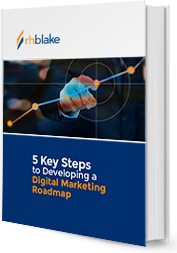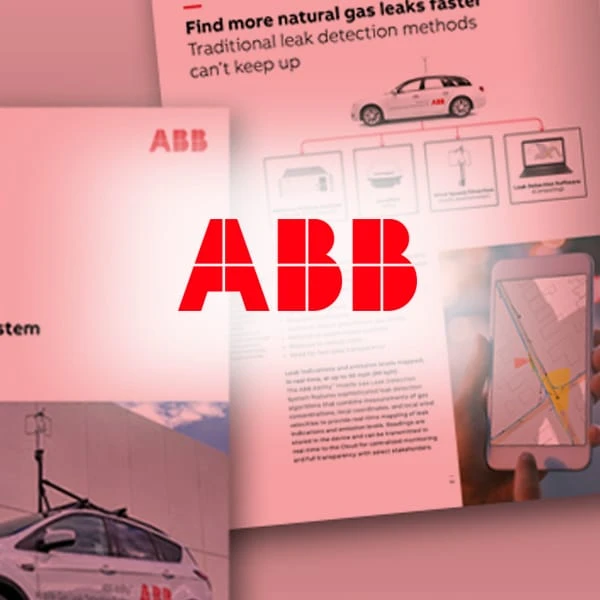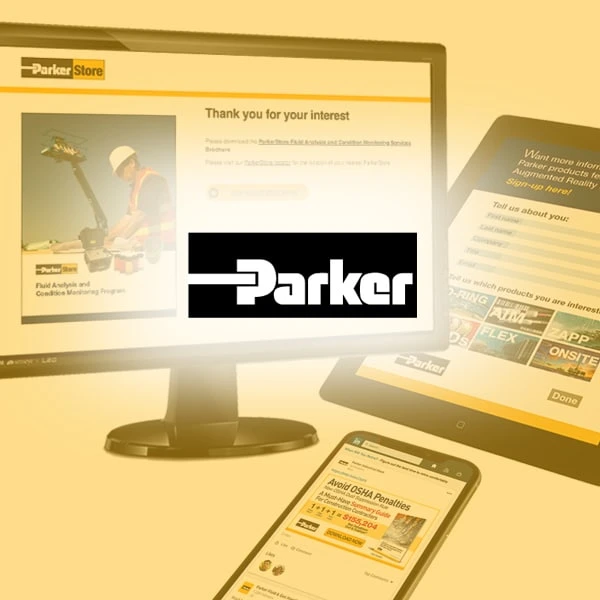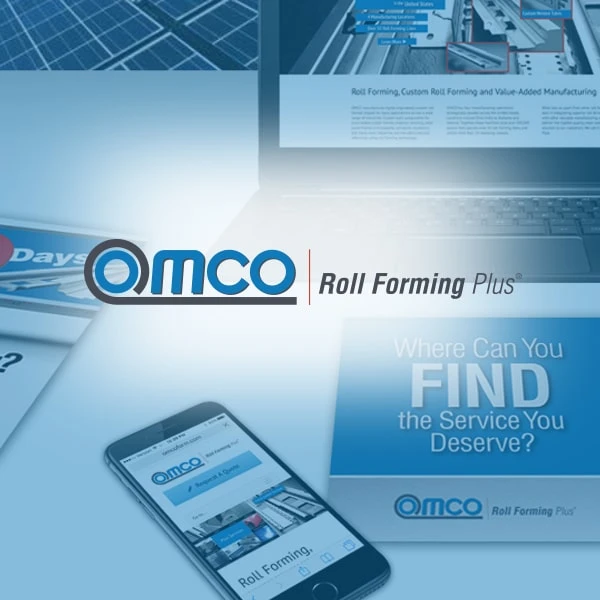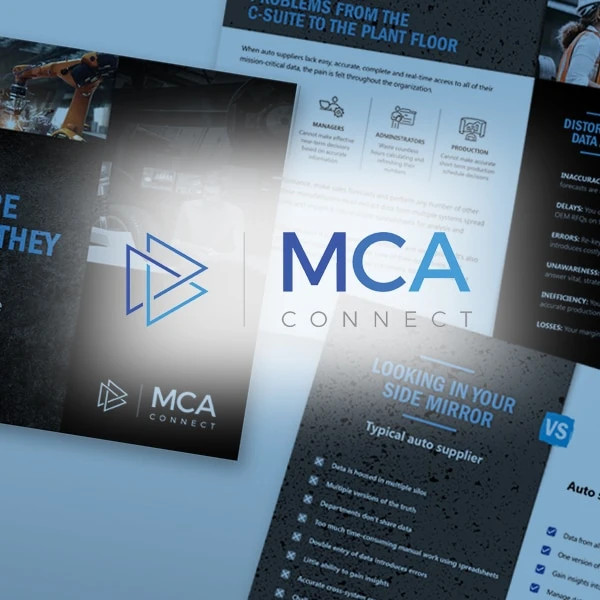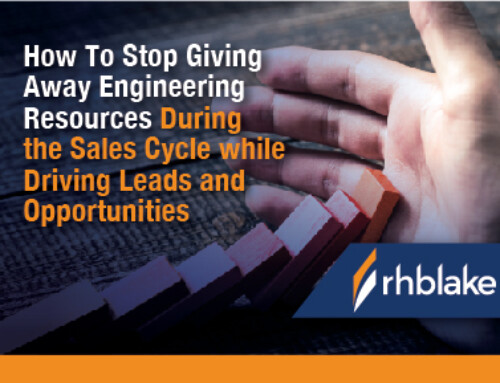One of your challenges as a B2B manufacturer is winning new accounts.
How Manufacturers Win Opportunities Without Being on Approved Vendor Lists
One of your challenges as a B2B manufacturer is winning new accounts. And the larger the account, the larger your challenge, because global OEMs and Tier 1 suppliers typically only work with companies who are on their lists of approved suppliers.
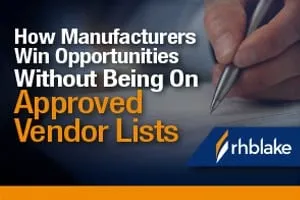
We say “typically,” because plenty of OEMs and Tier 1 suppliers will hire your firm even if you are not an approved supplier. While conducting hundreds of Voice of the Customer interviews with manufacturers of every size, we heard countless examples of manufacturers winning opportunities even when they weren’t on an Approved Vendor List. Here’s how they go about it.
Step 1: Understand approved vendor lists
An Approved Vendor List is a formal document that contains a list of suppliers, manufacturers, or vendors who have been approved by a company or organization to provide goods or services for their business. These lists are also known as Approved Supplier Lists, Approved Vendor/Supplier Programs, or Qualified Vendor Lists.
Manufacturers use Approved Vendor Lists to ensure that the suppliers or vendors they work with meet their specific standards and requirements for quality, reliability, and safety. By maintaining a list of pre-approved suppliers, they both reduce the risks associated with working with unknown vendors, and streamline their procurement process. This also helps them negotiate better pricing, and build stronger relationships with their suppliers over time.
The process of becoming an approved vendor typically involves an initial qualification review, which assesses a supplier’s financial stability, quality control processes, manufacturing capabilities, and compliance with applicable regulations. Once approved, vendors are regularly monitored and evaluated to ensure they continue to meet the manufacturer’s standards and requirements.
Overall, an Approved Vendor List provides a structured approach for large manufacturers to manage their supply chain and maintain consistent levels of quality and reliability in their products or services.
Step 2: Discover your competition
Before you can win an opportunity without being on an Approved Vendor List is to discover who is already on that list. You must know your competitors.
Discovering which companies are on an Approved Vendor List typically requires some level of interaction with the company or organization that maintains the list. Here are some steps to take to discover who you are up against.
- Search online: If the company has a publicly available Approved Vendor List, it may be posted on their website or on other online platforms. Try conducting a search using keywords such as “approved vendor list” or “qualified vendor list” along with the company’s name.
- Read the company’s news page: Look through news releases for the past few years to see which firms the OEM has awarded multiple contracts to. These firms are likely approved suppliers.
- Ask the company for their list: Reach out to the company’s procurement or purchasing department and ask if they maintain a list of approved suppliers. They may give you a copy of the list or direct you to where it can be found.
- Check with industry associations: If the company operates in a specific industry, check with relevant industry associations to see if they have any information on the company’s Approved Vendor List or approved suppliers in that industry.
Step 3: Discover your differentiation
The key element to understand about Approved Vendor Lists is that they help OEMs mitigate risk. The secret to winning contracts when you are not an approved vendor is demonstrating that you offer a differentiated product or service with minimal risk.
Before you approach an OEM with a sales pitch, you must have a differentiated offering and a strategy. OEMs are unlikely to consider hiring you when a supplier on their Approved Vendor List already offers what you offer. You must stand out by offering something that no approved vendor offers. There are multiple ways to differentiate yourself.
- Focus on your unique selling proposition: Identify what makes your company different from the approved vendors. This could be a new offering, unique process, technology, or capability that the other vendors do not offer. Once you have identified your unique selling proposition, emphasize it in your communications with the OEM.
- Create a secret sauce: Does your firm have unique expertise, proven methodology, patented process or “secret sauce?” Create one and you will immediately stand out against approved vendors.
- Emphasize your domain expertise: Closely related to secret sauces is domain expertise, the more relevant, the better. For instance, have you worked with a competitor of the OEM on a similar project and achieved successful results?
- Reduce risk: Has a company that maintains an approved supplier list hired your firm even though you are not on that list? Are they happy with the results you delivered? Use that experience as proof that hiring you is a low-risk proposition for an OEM.
- Emphasize performance: Another way to eliminate perceived risk is to propose a performance-based agreement. Offer to perform work, or deliver a product or service, and be compensated for your efforts based upon performance alone.
- Offer a specialized service or product: Identify a service or product that is not currently offered by the approved vendors, and then specialize in that offering. Think of unique applications for your product or service in particular. This gives you a competitive edge over the other vendors and make it more likely for the OEM to consider you for future projects.
- Provide excellent customer service: A strong focus on customer service can differentiate your company from other vendors, especially if you can provide better response times, more personalized attention, or more flexible solutions. Make sure to communicate your commitment to customer service in all of your interactions with the OEM.
- Offer competitive pricing: If your company can offer competitive pricing, you may be able to secure business from the OEM even if you are not on their Approved Vendor List. Make sure to emphasize the cost savings that your company can provide while still maintaining quality and reliability.
- Build relationships with the OEM: Building strong relationships with the OEM’s procurement team positions your company as a valuable partner, even if you are not yet an approved vendor. For example, attend industry events and conferences where you network with the OEM’s procurement team, and keep in regular contact with them to stay top-of-mind for future projects.
- Think geography: Sometimes, what you offer is not as important as where you offer it. If you are the only firm of your kind in your region, and if no firms on the Approved Vendor List operate in your region, you will be an attractive option for an OEM.
Step 4: Start small
Large companies that maintain Approved Vendor Lists will take a look at your company if your offering is unique and if the risk of working with you is acceptable. One way to reduce perceived risk is to pitch a small initial engagement. Offer to deliver a product or service as a proof of concept, a way for the OEM to dip their foot in the water without having to jump right in. The more attractive you make this proposal, the better.
So, consider what a typical contract looks like in terms of stages, phases, products, services, deliverables, timelines and budget, and offer a mini version of that engagement. Think small and you might just win big.
An example
To understand these best practices for landing contracts when you are not on an Approved Vendor List, picture this example.
A company manufactures filters used in oil and gas processing. Their filters are commodity products that they already sell to some large Engineering, Procurement and Construction (EPC) firms.
The company wants to penetrate the liquid natural gas (LNG) market. So, the company tweaks a line of its existing filters to suit a few of the unique processes used in LNG processing.
The company then takes an account-based marketing approach to target procurement managers, process engineers and other key decision makers at key accounts. The company starts a podcast aimed at the LNG market, hosts online events, and begins publishing a series of articles and thought-leadership pieces that demonstrate the company’s differentiated filter offering for the LNG market.
This strategic approach gets the attention of some key stakeholders, and eventually leads to a few OEMs hiring the company to supply their LNG filters as a pilot project—even though the company is not an approved vendor.
Conclusion
You can land contracts with large buyers even though you are not on their Approved Vendor Lists. The key is to differentiate your offering and to reduce perceived risk. When you differentiate your offering, understand an OEM’s needs and preferences, and focus on providing value in areas where the approved vendors can’t compete, you win.
By emphasizing your unique selling proposition, offering specialized services or products, providing excellent customer service, offering competitive pricing, and building relationships with the OEM, your company can stand out and secure contracts even if you are not on an Approved Vendor List.
If you need help discovering your differentiator, talk with the team at RH Blake.
One of your challenges as a B2B manufacturer is winning new accounts.
How Manufacturers Win Opportunities Without Being on Approved Vendor Lists
One of your challenges as a B2B manufacturer is winning new accounts. And the larger the account, the larger your challenge, because global OEMs and Tier 1 suppliers typically only work with companies who are on their lists of approved suppliers.

We say “typically,” because plenty of OEMs and Tier 1 suppliers will hire your firm even if you are not an approved supplier. While conducting hundreds of Voice of the Customer interviews with manufacturers of every size, we heard countless examples of manufacturers winning opportunities even when they weren’t on an Approved Vendor List. Here’s how they go about it.
Step 1: Understand approved vendor lists
An Approved Vendor List is a formal document that contains a list of suppliers, manufacturers, or vendors who have been approved by a company or organization to provide goods or services for their business. These lists are also known as Approved Supplier Lists, Approved Vendor/Supplier Programs, or Qualified Vendor Lists.
Manufacturers use Approved Vendor Lists to ensure that the suppliers or vendors they work with meet their specific standards and requirements for quality, reliability, and safety. By maintaining a list of pre-approved suppliers, they both reduce the risks associated with working with unknown vendors, and streamline their procurement process. This also helps them negotiate better pricing, and build stronger relationships with their suppliers over time.
The process of becoming an approved vendor typically involves an initial qualification review, which assesses a supplier’s financial stability, quality control processes, manufacturing capabilities, and compliance with applicable regulations. Once approved, vendors are regularly monitored and evaluated to ensure they continue to meet the manufacturer’s standards and requirements.
Overall, an Approved Vendor List provides a structured approach for large manufacturers to manage their supply chain and maintain consistent levels of quality and reliability in their products or services.
Step 2: Discover your competition
Before you can win an opportunity without being on an Approved Vendor List is to discover who is already on that list. You must know your competitors.
Discovering which companies are on an Approved Vendor List typically requires some level of interaction with the company or organization that maintains the list. Here are some steps to take to discover who you are up against.
- Search online: If the company has a publicly available Approved Vendor List, it may be posted on their website or on other online platforms. Try conducting a search using keywords such as “approved vendor list” or “qualified vendor list” along with the company’s name.
- Read the company’s news page: Look through news releases for the past few years to see which firms the OEM has awarded multiple contracts to. These firms are likely approved suppliers.
- Ask the company for their list: Reach out to the company’s procurement or purchasing department and ask if they maintain a list of approved suppliers. They may give you a copy of the list or direct you to where it can be found.
- Check with industry associations: If the company operates in a specific industry, check with relevant industry associations to see if they have any information on the company’s Approved Vendor List or approved suppliers in that industry.
Step 3: Discover your differentiation
The key element to understand about Approved Vendor Lists is that they help OEMs mitigate risk. The secret to winning contracts when you are not an approved vendor is demonstrating that you offer a differentiated product or service with minimal risk.
Before you approach an OEM with a sales pitch, you must have a differentiated offering and a strategy. OEMs are unlikely to consider hiring you when a supplier on their Approved Vendor List already offers what you offer. You must stand out by offering something that no approved vendor offers. There are multiple ways to differentiate yourself.
- Focus on your unique selling proposition: Identify what makes your company different from the approved vendors. This could be a new offering, unique process, technology, or capability that the other vendors do not offer. Once you have identified your unique selling proposition, emphasize it in your communications with the OEM.
- Create a secret sauce: Does your firm have unique expertise, proven methodology, patented process or “secret sauce?” Create one and you will immediately stand out against approved vendors.
- Emphasize your domain expertise: Closely related to secret sauces is domain expertise, the more relevant, the better. For instance, have you worked with a competitor of the OEM on a similar project and achieved successful results?
- Reduce risk: Has a company that maintains an approved supplier list hired your firm even though you are not on that list? Are they happy with the results you delivered? Use that experience as proof that hiring you is a low-risk proposition for an OEM.
- Emphasize performance: Another way to eliminate perceived risk is to propose a performance-based agreement. Offer to perform work, or deliver a product or service, and be compensated for your efforts based upon performance alone.
- Offer a specialized service or product: Identify a service or product that is not currently offered by the approved vendors, and then specialize in that offering. Think of unique applications for your product or service in particular. This gives you a competitive edge over the other vendors and make it more likely for the OEM to consider you for future projects.
- Provide excellent customer service: A strong focus on customer service can differentiate your company from other vendors, especially if you can provide better response times, more personalized attention, or more flexible solutions. Make sure to communicate your commitment to customer service in all of your interactions with the OEM.
- Offer competitive pricing: If your company can offer competitive pricing, you may be able to secure business from the OEM even if you are not on their Approved Vendor List. Make sure to emphasize the cost savings that your company can provide while still maintaining quality and reliability.
- Build relationships with the OEM: Building strong relationships with the OEM’s procurement team positions your company as a valuable partner, even if you are not yet an approved vendor. For example, attend industry events and conferences where you network with the OEM’s procurement team, and keep in regular contact with them to stay top-of-mind for future projects.
- Think geography: Sometimes, what you offer is not as important as where you offer it. If you are the only firm of your kind in your region, and if no firms on the Approved Vendor List operate in your region, you will be an attractive option for an OEM.
Step 4: Start small
Large companies that maintain Approved Vendor Lists will take a look at your company if your offering is unique and if the risk of working with you is acceptable. One way to reduce perceived risk is to pitch a small initial engagement. Offer to deliver a product or service as a proof of concept, a way for the OEM to dip their foot in the water without having to jump right in. The more attractive you make this proposal, the better.
So, consider what a typical contract looks like in terms of stages, phases, products, services, deliverables, timelines and budget, and offer a mini version of that engagement. Think small and you might just win big.
An example
To understand these best practices for landing contracts when you are not on an Approved Vendor List, picture this example.
A company manufactures filters used in oil and gas processing. Their filters are commodity products that they already sell to some large Engineering, Procurement and Construction (EPC) firms.
The company wants to penetrate the liquid natural gas (LNG) market. So, the company tweaks a line of its existing filters to suit a few of the unique processes used in LNG processing.
The company then takes an account-based marketing approach to target procurement managers, process engineers and other key decision makers at key accounts. The company starts a podcast aimed at the LNG market, hosts online events, and begins publishing a series of articles and thought-leadership pieces that demonstrate the company’s differentiated filter offering for the LNG market.
This strategic approach gets the attention of some key stakeholders, and eventually leads to a few OEMs hiring the company to supply their LNG filters as a pilot project—even though the company is not an approved vendor.
Conclusion
You can land contracts with large buyers even though you are not on their Approved Vendor Lists. The key is to differentiate your offering and to reduce perceived risk. When you differentiate your offering, understand an OEM’s needs and preferences, and focus on providing value in areas where the approved vendors can’t compete, you win.
By emphasizing your unique selling proposition, offering specialized services or products, providing excellent customer service, offering competitive pricing, and building relationships with the OEM, your company can stand out and secure contracts even if you are not on an Approved Vendor List.
If you need help discovering your differentiator, talk with the team at RH Blake.

"RH Blake has helped us penetrate our target markets by implementing a more end-customer focused marketing approach. Leveraging the insights gained during the initial strategy work, RH Blake has created marketing programs that have generated awareness, preference and leads among a highly technical, risk-averse audience."
 Casey Bowes,
Casey Bowes,
CEO
Finish Thompson Inc.
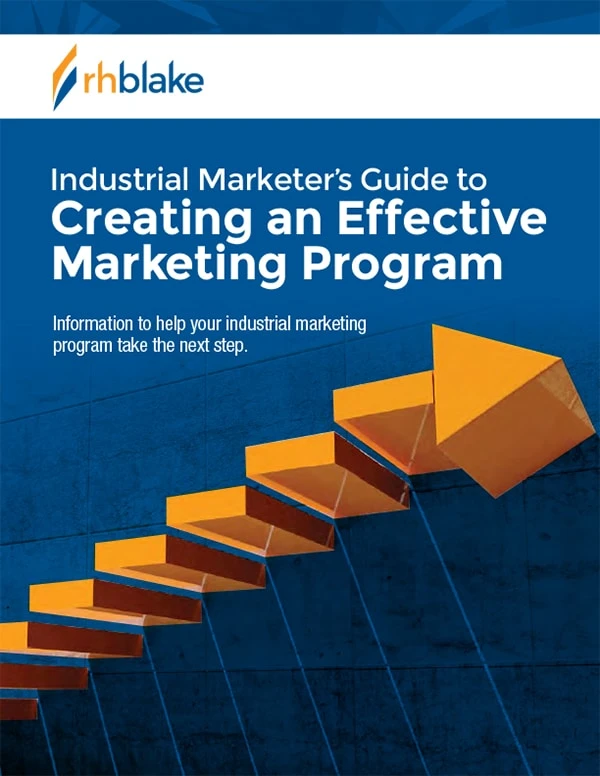
Industrial Marketer’s Guide to Creating an Effective Marketing Program
147 pages of actionable ideas to help you create a winning marketing strategy and program

Industrial Marketer’s Guide to Creating an Effective Marketing Program
147 pages of actionable ideas to help you create a winning marketing strategy and program
Related Clients


